| |

Home
Thousands of tastings,
all the music,
all the rambligs
and all the fun
(hopefully!)


Whiskyfun.com
Guaranteed ad-free
copyright 2002-2021
|
 |
|
| Hi, this is one of our (almost) daily tastings. Santé! |
| |
|
| |
| |
January 1, 2021 |
|
  |
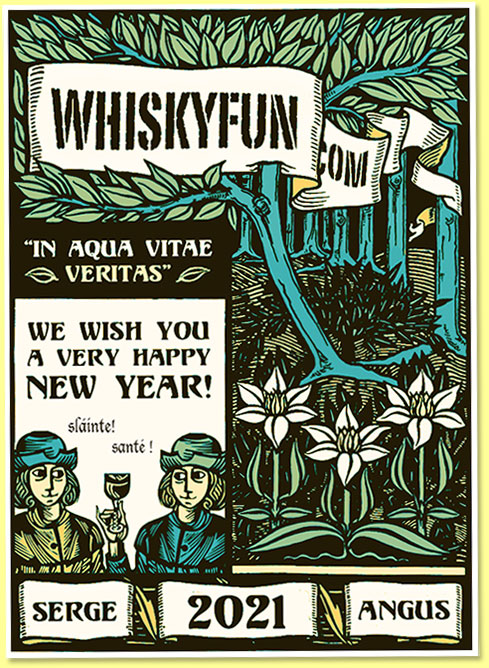
|
|
Angus's Corner
From our Scottish correspondent
and skilled taster Angus MacRaild in Edinburgh |
 |
|
| Ancient Malts To Welcome 2021 |
| There has always seemed to be a great division of feeling around this time of year. Some relish the festive spirt of waving goodbye to one year and ushering in the new one. A time of renewal, fresh beginnings, sharpened resolve, keeping the fire alive through the darkest winter nights and all sealed with a good dash of hedonism. |
|
Then there is the other side which feels the winter blues more keenly, feels the darkness press in a little too tightly. Those that want to go to bed early and recoil from the sense of time passing; another year gone and things unfinished - or yet to be started. I’ve always felt naturally at home in the former category, indeed I’ve always cherished our Hogmanay celebrations here in Scotland. It’s a time which lends itself naturally to friends, family, cosy fires, music and whisky. Obviously, 2020 has been a year unlike any other, and for me there’s a weight of melancholy that hangs around this Hogmanay. There won’t be any grand celebrations this year, glad as I am to see the back of 2020 and hopeful as I am that 2021 will be, at the very least, better. However, one thing remains consistent, and that is my desire to focus on what should almost certainly be some great and fascinating whiskies to mark the turning of the year. I’ve been sitting on these samples for a while now, waiting to see if fitting sparring partners would show up, but I think instead it would be more fitting to just do them all in one short and sweet blaze of glory. |
|
|
Happy new year and here’s to 2021! |
|
|
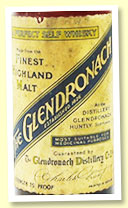 |
Glendronach NAS (75 proof, OB, 1950s) 
A bottle I opened for my 30th birthday, which feels like it was but a mere few of centuries ago. This is my last sample and I realised I never wrote notes, so let’s send it out in style. Needless to say this livery is pretty iconic and has influenced more than a few labels over the years… Colour: deep gold. Nose: this extremely typical profile that meshes old style malt whisky with old bottle effect. Metal and shoe polishes with mechanical oils, greasy toolbox rags, hessian and a rather light and fragrant peat with herbal shades. Getting rather sooty and also meaty with many meat stocks, bouillon, bone marrow and coal smoke. A style which just does not exist at all anywhere in today’s world as far as I’m aware. Sheep wool, mutton, suet, linseed oil, mushroom tea. Hypnotically fascinating stuff that you could nose and dissect for hours. Mouth: it’s peatier than I recall, but perhaps time away from the bottle with a touch of air has done that. I’d also say it feels weightier than 43%. There’s a lot of dry herbs, wee tarry notes, black pepper, smoked teas and its extremely camphory with olive and cod-liver oils. Some more metallic touches which is this OBE coming through again. Peaty, savoury, roots, umami and full of turf, dried herbs, meat stocks and various broths and soups. Finish: good length, on metal polish, black pepper, wood spices, lanolin, camphor, tar, soot and leaf mulch. Some wonderfully soft and spicy peat smoke in the aftertaste. Comments: Deeply emotional whisky to try, even if it isn’t quite perfect and that you can feel these wee inclusions of OBE diminish it in a technical sense slightly. It’s still a remarkable education to experience such flavours. Now, to find a 100 proof version…
SGP: 373 - 88 points. |
|
| |
|
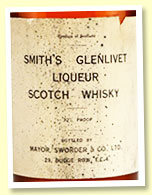 |
Smith’s Glenlivet Liqueur Scotch Whisky (70 proof, Mayor, Sworder & Co Ltd, 1930s) 
An ancient bottle, very generously opened by Olivier. This bottle ended up as part of a large whisky collection in Denver Colorado, before finding its way back to Scotland to finally be cracked open in Edinburgh. These rather amazing journeys are always part of the joy of such old bottles to me - and why I think it’s worth keeping bottles for the future on occasion. Colour: brownish amber. Nose: ahh, an exquisite nose. Quinces, tinned fruits in syrup, peaches, apricots, plum wine, ancient sauternes, long-aged mead, very old yellow Chartreuse. One of those old bottles that says ‘liqueur’ and makes you really wonder if some sort of ex-Benedictine cask wasn’t involved at some point. The whole profile just screams syrupy, sticky, sugary maturity. Myriad notes of jams, fruit preserves and cordials. In the background tiny notes of rancio and wee herbal waxy touches. Mouth: it’s undeniably fragile. But there’s beauty here aplenty too. Manuka honey, praline, dark chocolate truffle, cocoa powder, aged mead that’s drying out, herbal extracts and generally more of these herbal liqueur profiles. Seriously, did they add sugar to this? It wouldn’t surprise me in the least, I’m sure there are many, many practices common in this era that we just know nothing about now. Swept under the carpet of history. Anyway, there’s now also some raisins, cream sherry and chocolate liqueur drizzled over boozy cherries. I’m getting carried away here. Finish: medium and returning to this impression of boozy winter fruits. Christmas pudding drowned in old armagnac, apricot brandy and still this wonderfully persistent chocolatey vibe. Comments: You could quaff litres of this stuff at this time of year. The nose was utterly spellbinding, whereas the palate probably lacked a few notches of oomph. This bottled around 46% would have been a total killer. However, as it is, this is still rather heartbreaking beautiful ancient malt whisky. Tastes like they added around one or two bushes of old Chateau d’Yquem though.
SGP: 652 - 91 points. |
|
|
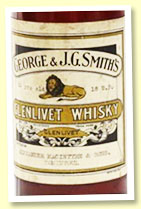 |
Glenlivet 12 yo (18 under proof, Alexander MacKintyre & Sons of Tomintoul, circa 1920s) 
An ancient bottle with a driven cork probably from around the early 1920s. 18 under proof equates to 46.8% in today’s money, although this one may have lost one or two degrees along the way. Once again we have Olivier to thank for opening this amazing old relic. Colour: gold. Nose: yellow fruits, acacia honey, overripe melon, peaches, nectar, pollens - the most stunningly elegant and layered aroma. It oozes this impression of fatness and texture but is also riddled with these soft, complex fruity touches which you just almost never find in such ancient bottles. Tinned fruits preserved in their own syrups, yellow flowers and ancient meat laced with salt. Hypnotic and totally stunning. Mouth: the insulation provided by the higher alcohol is immediately evident. The mouthfeel is just wonderful and this sense of synchronicity with the nose - that you rarely get with much older whiskies - really sings here with all these sticky yellow fruits and syrups. Quince, apricot jam, golden sultans, the most gentle and elegant of peat smokes and wee herbal kisses. Beyond that the complexity really builds with orange peel, rose syrup, cardamom and bitter herbal teas. Finish: medium and on many softer spice tones, white pepper, bitter citrus piths, kumquat and some rather dusty but punchy waxiness. Comments: Spellbinding, haunting old malt whisky. Once again a flavour profile which is totally extinct but, unlike the Glendronach for example, there’s a little more shared DNA with later production decades in terms of the freshness and ripeness of the fruit components. However, that may just be the preservative power of the higher alcohol, which has clearly worked some serious magic here. Anyway, whatever alchemy is at play, this is an utterly incredible old bottle!
SGP: 652 - 93 points. |
|
|
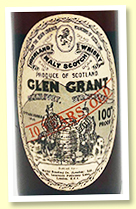 |
Glen Grant 10 yo (100 proof, Moray Bonding Co, 1950s) 
Old single malts at 100 proof from this era are extremely rare, so understandably I was very happy to get my hands on this one. A bottle I opened for the Whisky Show Old & Rare back in February at the start of this year, a mere 150 years ago… Colour: deep gold. Nose: pow, and you’re dead! Just a bewildering mix of natural tar, nectars, soft, herbal peat smoke, crystallised orange peel, mead, old green Chartreuse and many tiny notes of dried flowers, juniper, exotic fruit teas, waxes, old leather, toolboxes, bouillon and various meat stocks and broths. This very umami / savoury / herbal profile that very old malts such as this seem to display in abundance. You really get the impression this is something to do with peat and the way it kind of crumbles in the bottle over the course of decades into myriad sub-component flavours and aromas. With water: only one or two drops and it becomes amazing, similar in profile but with the fruits elevated and in harmony with these other aspects. Dried and crystallised citrus and exotic fruits, herbal and smoked teas and a rather pristine and chiselled salinity. Mouth: gah! Just immense! Like a smoothie made of leather and pure tar! Flinty, smoky minerals, meat broths mixed with kerosine, tarred old rope, camphor, pine resins, herbal-infused olive oil, slated liquorice and even wee touches of brine and deep, muscular peat smoke now. Utterly stunning! With water: holy shit! I’m sorry but this is becoming utterly incredible. Call the anti-maltoporn brigade, immediately if you don’t mind, although I know they’re busy at this time of year. Finish: endless, utterly hypnotic, poetically glorious, mind-blowing and peaty! Comments: Between this and the Glenlivet 12 yo you just know that alcohol is the key to whisky’s long-term preservation in glass. Even bottles with good levels suffer over decades with OBE it seems, whereas here the level was on the low side and time seems to have done it nothing but wonders. A spellbinding and utterly brilliant whisky that reminds you why you love this daft spirit in the first place.
SGP: 575 - 95 points. |
|
|
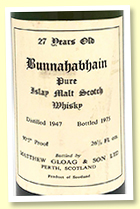 |
Bunnahabhain 27 yo 1947/1975 (90.5 proof, Matthew Gloag & Son) 
At the time I think this would have counted as a semi-official bottling. There’s also a more common version at 75 proof, however this version at what is almost certainly natural strength (51.6%) is the only version of this one I ever saw. Another bottle I cracked for Old & Rare earlier this year and one that Serge already recorded notes for and was suitably impressed (WF 94). Colour: gold. Nose: of course Bunnahabhain during this era was - like all Islay makes at the time - peated. Here is shows in abundance and in fact it kind of speaks with a Bowmore accent as there’s many subtle fruits emerging alongside this extremely elegant, coastal peat smoke profile. Seawater, pink grapefruit, lemon peel, guava and then tarred hessian, camphor and smoked sea salt with iodine drops. Medicines, pristine salinity, natural tar and many delicate coastal aspects underneath. Stunning complex and playful in the way it keeps on evolving. With water: fruits, fruits, fruits. But gently so, this sense of delicate and poised fruitiness composed of crystallised grapefruit, lime, kumquat and passion fruit. Mouth: oh dear, this is incredible. The peat on the nose plays tricks with you and you could almost think it’s some top notch 60s Islay whisky, but here there’s no room for equivocating - this is something more old school altogether. The texture and the weight are incredible. Fat, glycerol peat, herbal, turfy smoke and an almost gelatinous medicinal quality. The fruits are also there but it’s more towards tangerines, grapefruit, blood orange and many rather sappy and herbal extract aspects, wintergreen, sandalwood and fir wood. With water: cohesion and perfection. All aligning on this extremely syrupy, textural collision of oily peat, herbal liqueurs, fruit syrups, cough medicines, wormwood and tiny flashes of wonderfully fresh salinity and coastal touches. Finish: long and extremely resinous, herbal, sooty, delicately peaty, smoky and medical. More crystallised fruits too. Comments: Amazing to try such an ancient Islay whisky, especially one that shed its peat so notably for several decades later on, which really serves to emphasise what a historical and different style this is. Like the Glen Grant, the ABV here has really preserved it, and what you’re left with is a profoundly vivid and irrefutable impression of just how different Scottish malt whiskies tasted in these eras. I think I concur with Serge on this one.
SGP: 666 - 94 points. |
|
|
Serge's turn to celebrate 2021, with... |
Seven old French brandies
for The New Year |
Let’s just further plunder WF’s shelves and boxes, while hoping that this year brings great new whiskies, brandies and rums, as well as new goals, new achievements, and unknown aromas and flavours. Wishing you a year loaded with more happiness and better ethanol. Remember, in that respect less is more, provided it is better. Happy New Year! |
Now, on to this wee box… And why not kick this off with a little 1979? |
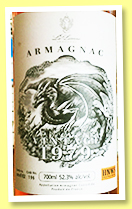
|
La Licorne 1979 (52.3%, OB for HNWS Taiwan, armagnac, cask #196, 432 bottles) 
I’ve never heard of La Licorne (The Unicorn) but that doesn’t mean much. We don’t do dragons either ;-). Colour: very deep gold. Nose: it is a pretty easy armagnac, both fresh and fruity and on muscovado sugar and roasted raisins. A little toasted oak, some fudge, peach jam, vieille prune, vin doux naturel, some caramel, a wee feeling of PX… With water: chocolate and cigars, espresso coffee, a drop of old balsamic vinegar, touches of clove, then menthol and pine resin… That’s all well and good, and what one should expect from some well-aged classic armagnac that’s been dating old oak for years and years. Mouth (neat): on ripe fruits, including green ones (gooseberries, greengages, rhubarb – hardly a fruit, I know)… Then toasted oak and toffee, plus bags of raisins. Crunching coffee beans, that’s the wood. With water: peppers, coffee dregs, cocoa, lemon zests, pine resin… Once again, this is very good classic armagnac. Finish: rather medium, mentholy, with a tiny pinch of salt and even more ground coffee in the aftertaste. We’ve had a whole spoonful. Also a little marmalade, a little black pepper. Comments: a pretty dry high-quality armagnac. You could have this instead of coffee as your postprandial drink.
SGP:362 - 85 points. |
Let’s go back to the Beatles… |
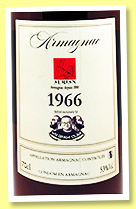
|
Aurian 1966/2020 (53%, OB for Wu Dram Clan, armagnac) 
The 1979 by Aurian had been really good, if a tad too wooded for me. Colour: red copper amber. Nose: all right, pinewood, terpenes, saps, putty, carbolineum, glue, pinecones… Well, in theory, this should be very woody indeed, but let’s let water work its magic… With water: classic acetone-y notes for a short while, nail polish remover, then many more pine needles, eucalyptus, beedis, lemon essence, lemongrass and just walnuts, so all is fine now and even more than that. Lovely nose once you’ve talked to it. Mouth (neat): a lot of oak (and affiliated molecules) but on the other hand, there’s a thick, almost creamy fruitiness (apricots, oranges, plums) that kind of balances all that. With water: tart oak and grape-iness, this could almost have been marc de Bourgogne. Perfect drop when you go skiing, with just the right amount of rusticity. Finish: long, still a notch on glue and pine essence. Swiss chards, cocoa, black tobacco (Gitanes). Comments: some very good old and rustic armagnac that will remind everyone that it was made in the country. Similar style as that of the Licorne.
SGP:362 - 85 points. |
Since we’re in the mid 1960s… |
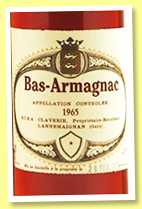
|
Domaine de Baraillon 1965/2019 (45%, OB, Bas-armagnac) 
Crikey, I’ve still got the taste of that 1918 on my tongue and in my mind. What a drop that was, I’m glad I managed to secure a bottle (in pre-Brexit terms, neener-neener!) Colour: dark amber. Nose: blam. Cheng-pi (dried fermented mandarin skins), liquorice, menthol, aniseed, pinewood, verbena… Really in another league, Baraillon… Mouth: just like the others, it starts a little dry and oaky, perhaps a little too much on over-infused black tea and ultra-black chocolate, but oranges both bitter and regular are bailing out in the background. Having said that, it may not display the same sheer brightness as other Baraillons. More Gitanes tobacco (did the distillers throw a few butts of ‘papier maïs’ into the still, back in 1965?) We’ll never know… Finish: rather miraculous since oranges, olive oil and honey seem to be willing to come to the rescue. Having said that, oak, cocoa and Gauloise butts are back in the aftertaste. Comments: absolutely lovely, but as I said… Some have been better in my book. High mark though.
SGP:451 - 86 points. |
The next one should make perfect sense… |
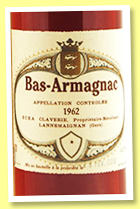
|
Domaine de Baraillon 1962/2019 (40%, OB, Bas-armagnac) 
Watch it, only 40% vol., so danger zone ahead of us… The swinging sixties, they said… Colour: copper amber. Nose: it is soft and you would sometimes believe you’re nosing some very old moscatel. Nothing wrong in that. Now you could also believe you’re nosing some 1938-1940 Macallan, if that rings a bell to you. Splendid figs and quinces, melissa water, honeys, a tiny metallic touch, one of dried mushrooms, cigars, old furniture polish (old presbytery), chocolate and tobacco, bergamots, lanolin, dried goji berries, raisins… The complexity is rather astounding here, it’s just that those 40% vol. are scaring us to death. What will happen on our palates?... Mouth: well well well, we wouldn’t have refused two or three extra-percents, I’m afraid most ‘modern palates’ would find this a tad flabby, despite the brilliant range of fruity, floral and herbal aromas that come before thee. On the other hand, who would resist quince jelly? And baklavas? Orange blossom water? Wormwood and woodruff? Yellow chartreuse? It’s just that I’m missing those two extra-degrees. Excuse me? Add a few drops of full-strength vodka? You’re not serious! Finish: rather short, as expected, but complex, rather more on tobacco and walnut skins. Comments: fantastic armagnac. I may try to add a few drops of high-strength vodka but I first need to make sure no one’s watching.
SGP:651 - 88 points. |
Wouldn’t the answer lie in history? Let’s see… |
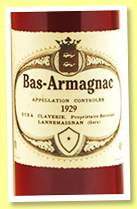
|
Domaine de Baraillon 1929/2019 (40%, OB, Bas-armagnac) 
Imagine, 1929. I’m sure this one’s spent some time in demi-johns. As for the vintage here, I sure shan’t mention the Great Depression, rather the fact that it was in 1929 that French Prime Minister Aristide Briand first brought up the subject of an European Federation. Colour: red amber. Nose: very delicate and extremely floral this time. Peonies, wallflowers, lilac, nectars and honeys… I believe this is rather sublime and that lower strengths do go well with this kind of profile. The exception that proves the rule. Old books and furniture, rosewood, cherry jam, viognier (or Condrieu), fig wine, drops of mead, tokay, a little mint and camphor… This really is a sublime nose. Mouth: a tad more gritty and rustic on the palate, almost calavados-y, with notes of sour apples and damson spirit. Vieille prune all over again, chouchen (distilled mead), even ‘Glenlivet’, some cocoa, black tobacco, overripe apples… Well let’s not quibble, it’s still excellent, it’s just that the nose was totally out of this world. Finish: medium and rather on roasted raisins and burnt brioche. Comments: it is extremely rare that I would go up to 90 just because of a stunning nose. Extremely rare indeed, but not totally unseen. Proof:
SGP:561 – 90 points. |
On to cognac and older-yet vintages… |
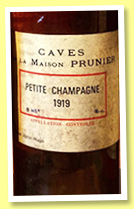
|
Petite-Champagne 1919 (43%, Maison Prunier Paris, +/-1950) 
Some lovely old cognac that Angus has found before Brexit. It’s to be noted that this is not from the well-known cognac house Prunier – although it could be, rather from the very art-déco restaurant and delicatessen that’s located avenue Victor-Hugo in Paris and that used to belong to Yves Saint-Laurent for a while. I agree I should have tried this along the Baraillon 1918, but there, perfection is not of this world. Colour: deep gold. Nose: you have to understand that Maison Prunier has always been a luxury institution, more or less like Fauchon or Hédiard, and that shows in this superb nose. Certainly not one that would go into all directions, as it’s rather tight and focussed on honey, sultanas, mirabelles and just a tiny touch of eucalyptus. The thing is, those are ueber-first class honeys, sultanas, mirabelles and eucalyptus. Outstanding nose, as straight and immediate as a great chardonnay, for example. They’re never coming apart! Mouth: et voilà, perfection. Heather honey, peach in syrup (very obvious), quinces and figs – what a winning combo – and a fab oiliness on your tongue, as if someone had added some liquid beeswax into the casks. A little olive oil too, that’s always a great signature. Finish: medium, oilier yet, even more honeyed, and yet all elegance and, I would add, worthy discretion and precision. Comments: petite champagne, big cognac (why be so trivial, S.?) Stunning old bottle that should have benefitted from quite a few decades in the restaurant’s cellar. Also check the old cognacs at La Tour d’Argent next time you’re there.
SGP:651 - 93 points. |
Go further back or not go further back? Mind you, Covid could eat us right tomorrow, so why wait? |
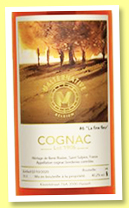
|
Héritage René Rivière Lot 1906 ‘La Fine Fleur’ (40,2%, Malternatives Belgium, Borderies, 2020) 
La fine fleur means the cream of the crop, while Lot 1906 should mean vintage 1906 – I suppose they just haven’t got all the proper records, stamps and signatures in the book. Provided they have the book, that is. But imagine, 1906, Clemenceau was probably the Prime Minister when this was distilled, as he took office on October 25, 1906. There were also great strikes in 1906, but well, this is France and France without strikes and demonstrations is like a guitar without strings. Did you know we even organise demonstrations for tourists? Every Saturday on the Champs-Elysées, starts around 14h00, don’t be late or you’ll miss the rubbish bins being set on fire and the water cannons! Colour: amber. Nose: forgot to say, this moving juice was transferred from oak to a demi-john in 1983, so technically, it should be around 77 years old. On the nose it’s rather on nuts and cakes, hazelnuts, biscuits, marzipan, apple compote, small bits of bananas perhaps, butter pears, hand cream… So it is pretty shy I would say, discreet, elegant… In short it does not impose itself at all. Mouth: it is still discreet and elegant, but it’s also got many more fruits than expected, with the aforementioned bits of bananas, as well as mead, the usual preserved peaches, and small herbal bits, coriander, lovage, mint… Pretty simple, but fresh and good. And remember, 1906. Finish: a little short but there, it’s refreshing and leaves no dryness. Unexpected strawberries in the aftertaste. Comments: I’ve just read that René Rivière, while he was a winegrower and distiller, has also been a ‘poilu’ in 1914/1918. But luckily, he came back from the great war while so many did not. I’m sure he’s had occasional sips of his very fine 1906 until his passing, in 1969.
SGP:641 - 85 points.
(95 emotional – à votre salut, René Rivière !). |
No 19th century brandy in the box, so I say ‘à la r’voyure and bonne année !’ Let’s see if little Whiskyfun will hold for one more year… |
(Merci Angus and everyone) |
|
|
| |
|
|
|
|
|
|

